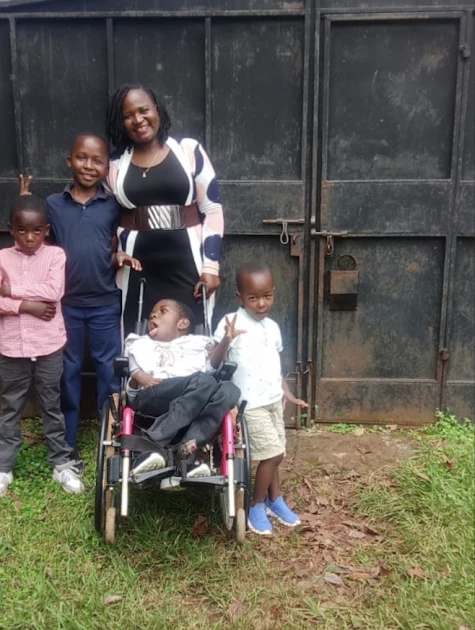Hope beyond diagnosis: The journey of a parent with a cerebral palsy child

Joy Lydia Juma with her children at her home in Namakhele, Bungoma County. Photo I Joy Lydia Juma
Joy Lydia Juma, a mother whose world almost went blank 12 years ago, sings for her son Dylan as he coos and moves his body to the rhythm of the song.
He lights up when he hears his favorite songs. Baby Dylan was born with cerebral palsy.
Amidst the daily challenges of rural life, the isolation and stigma that often accompanies disability and the limited access to healthcare, Joy’s determination to provide her child with a life of hope is everything to write home about.
This is an inspiring story of a mother’s unbreakable spirit and a journey filled with both heartache and immeasurable love.
Joy had a smooth pregnancy that she carried to term. “When my due date came, I walked myself into the then Bungoma District Hospital for delivery, on a Friday evening,” she begins.
“I was hoping to hold my bundle of joy after a few hours since I had begun laboring before I visited the facility. However, this was not the case. I instead labored for 48 freaking hours. By the time I gave birth on Sunday night, I was tired and weak. My beautiful baby came out silent; he didn’t cry like the other babies. I asked the midwife why my baby hadn’t cried immediately after birth, and she rudely told me to stop asking questions.”
Joy narrates to Citizen Digital how her newborn was wrapped in a leso and taken to the Special Care Nursery. Since she had had a perineal tear, she couldn’t move out of her bed.
She lay there in pain as she waited for the doctor in charge to stitch her up and perhaps bring her baby for breastfeeding and skin-to-skin contact.
She would wait a little longer and this made her worried. Her pain slowly disappeared, and she now wanted to know where her baby was.
“Daktari, is my baby alive?” she asked the midwife who had carried her baby to the newborn unit.
The midwife’s response broke her heart into pieces.
“Wacha kutusumbua wewe msichana. Mtoto wako ni mkubwa sana na hajalia bado. Huyo labda atakuwa punguani!” (Stop disturbing us, young lady. Your baby is too big and hasn’t even cried yet. That one will be an abnormal child!), the nurse bluntly responded. Joy’s baby was born weighing 5.2 kilograms.
More devastating news would hit this new mother after she later learnt that her poor baby’s hands were broken as the midwife pulled him out during delivery.
He couldn’t breastfeed as he didn’t have the suckling reflex. He stayed in the special care unit for one and a half weeks, being fed Nan through a tube.
Joy’s world had come down on her. Her husband, Abednego, who made daily visits, would hold his son’s tiny fingers as he stared at his delicate eyes in moments of silent happiness and confusion. No explanation would make him understand why their first child was the way he was.
Cerebral Palsy
When Joy and her husband went back to the facility after four months, they sought to know what was wrong with their baby. He couldn’t suckle. He made funny sounds. His neck was unstable. He drooled excessively and had delayed movements - the symptoms were worrying, and they hoped for some reassurance.
Doctor Aaron Lambisia walked in the small, sterile room wearing a smile on his kind face and a stethoscope around his neck – the traditional iconic medical doctor symbol.
There was silence for a minute as he tried to tickle baby Dylan, whom he had seen four months ago at the same facility. Dr. Lambisia was the one who plastered Dylan’s tiny broken hands before they left the hospital.
“Remind me the name of this little champ,” he asked. “Baby Dylan,” Joy answered.
“I want to be as honest as possible with you two, much as it might be difficult to hear,” the doctor began, trying so hard to measure his words. “Baby Dylan has been diagnosed with Cerebral Palsy”.
These words hung in the air and the well-lit small room suddenly seemed dark. Joy’s heart sank, her mind scrambling for the reality that had hit her.
Despite the kind way he delivered this news, the doctor’s words felt cold. He explained the condition in simple terms, outlining the next steps to treatment and management.
Cerebral Palsy (CP) is a neurological group disorder caused by a non-progressive brain injury or malformation that occurs while the child’s brain is under development.
It is usually caused by an injury to the brain before, during or after birth. ‘Cerebral’ refers to the brain, while ‘Palsy’ refers to muscle weakness and poor control. This condition may persist to older age and can lead to lifetime disability.
Baby Dylan suffered birth asphyxia, which means there was no oxygen and blood flow to the brain.
Joy’s prolonged labor led to her decreased energy levels, affecting her ability to push effectively, hence the baby’s fetal distress. Delayed delivery often causes complications that affect oxygen supply.
Occupational Therapy
The lifetime journey of caring for a child with special needs had just begun. Joy had no joy. This was the first time she had heard of Cerebral Palsy.
They would immediately start occupational therapy on baby Dylan at four months, twice per week.
“Children with Cerebral Palsy often have associated impairments such as cognitive, sensory, motor, feeding and swallowing difficulties, speech and language impairments among other disorders including orthopedic issues like joint deformities,” explains Douglas Misiko, a Pediatric Occupational Therapist at Kimilili Sub County Hospital.
The healthcare professional explains how therapy sessions and training help improve hand-eye coordination of children with CP and their ability to hold things like cups and spoons, which is a developmental progress.
“We always urge parents and caregivers to ensure that CP children attend all their scheduled therapy sessions, as these sessions also teach them how to avoid infections and prevent secondary disabilities,” he expounds.
Mama Dylan gives credit to Mr Misiko, who has walked her son’s journey for six years now. “He is very child-friendly and understanding. Douglas has been my baby’s therapist since 2019, and there has been great developmental progress in terms of movement and mindset. The two have an unbreakable bond. Dylan smiles and coos a lot when he sees him,” she says.
She also says her family and friends have been very supportive throughout this 12-year journey.
“Sometimes I have burnouts, I just want to go away and sit alone. Parents of children with CP go through a lot of psychological burnout. See, you need to heal before you can begin on the journey of helping your child live a normal life. My former classmates have always been my go-to when my world goes blank,” explains the Butere Girls High School alumna.
Joy, who has three other sons, Victor, 8 years, Sydney, 6, and Reign, 4 feels good when she sees them embrace their big brother with love and support.
She marvels at how Dylan has made his siblings be independent at an early age. Her heart swells with pride whenever she sees her four children interact in their unique way, erasing the tears she cries behind closed doors and the ‘why’s she asks God on her bad days.
“As we mark National Cerebral Palsy Awareness Day, Bungoma Cerebral Palsy Community CBO aims at raising awareness about CP within the community and beyond, reduce stigma and promote understanding and inclusion of individuals with the condition,” says Evans Jumba, the CBO’s founder.
“We have an awareness day in Kimilili Sub County Hospital on March 29. We are appealing to the County Government of Bungoma through the Ministry of Health to partner with us, as we support CP individuals,” he appeals.
According to Joy, CP is not covered by insurance because it is considered a pre-existing condition, and there is a lot of stigma and misconception about children born with this condition.
The medicines and therapy sessions cost around Ksh.10,000 per month are quite expensive for parents and guardians.
The mother of four voices her concern about the lack of special government learning facilities to accommodate children with CP and calls upon the government and policy makers to invest in the inclusion of children with disabilities.
“We should create a society that values and includes every child, regardless of their abilities. Inclusion is not just an issue of charity, it’s a matter of human rights,” she concludes.
Want to send us a story? SMS to 25170 or WhatsApp 0743570000 or Submit on Citizen Digital or email wananchi@royalmedia.co.ke
Comments
No comments yet.


Leave a Comment